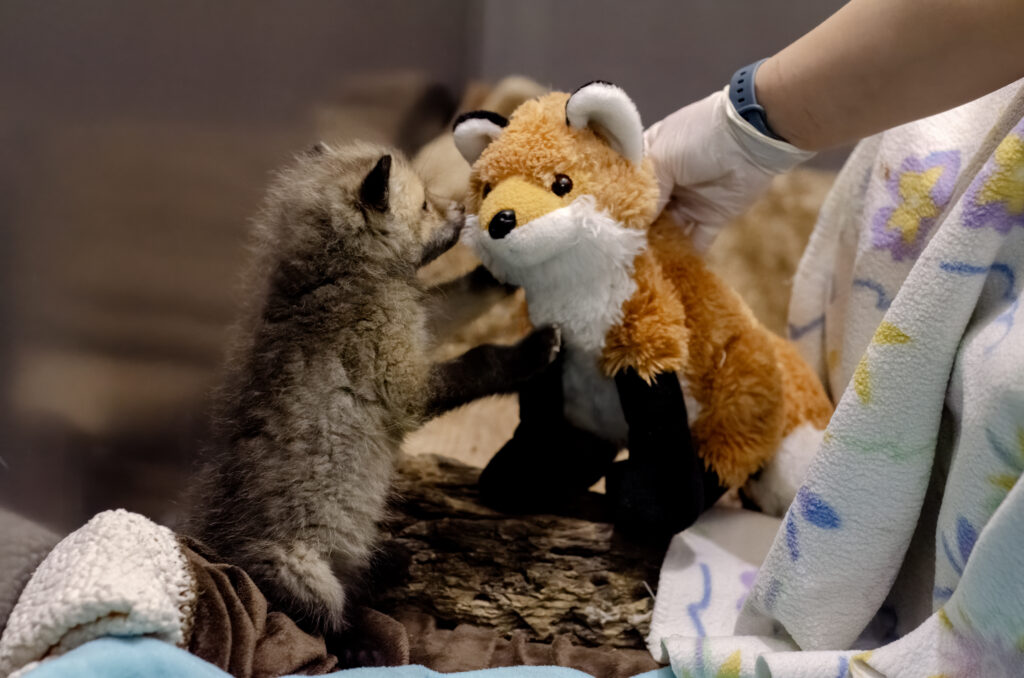By Katie Grant
Red foxes organize their small family groups (called “leashes” or “skulks”) through a social hierarchy. At the top of the pack are the breeding pair, called the alpha male and female, followed by a beta who helps care for newborn kits and maintain the group. When additional adults are present in the leash, more ranks, such as “delta” and “gamma,” may be established to reflect their standing. This hierarchy continues down to the lowest-ranking member, the “omega,” who is often the weakest and may be subject to mistreatment from other foxes.1
Typically, the alphas and betas are responsible for caring for the young. This social structure ensures that each fox has a defined role, and while the hierarchy is not fixed, an individual’s position can affect their access to food, which influences their growth, social interactions, and likelihood of dispersing from the group.1

The hierarchy among fox cubs develops early, with signs of dominance seen as young as one week old, as they compete for milk. In her studies using infrared cameras inside wild fox dens, Bristol University behaviourist Sandra Alvarez-Betancourt, observed that aggression was one of the cubs’ first social behaviours, beginning around three weeks old. Interestingly, the mother does not intervene in these squabbles. Researcher David Macdonald also noted that the individual personalities of the cubs become apparent as early as two weeks, with the runt, or “omega,” being harassed by its littermates from this early age. Fox cubs spend much of their time engaging in play fighting, which not only reinforces their position in the group’s hierarchy, but also serves as an important developmental activity.2

While many people associate foxes with the sights, or more often the sounds, of physical fights, conflict isn’t always necessary for maintaining social order. Fights, when they do occur, tend to happen later in a confrontation. In general, foxes avoid fighting because it consumes a lot of energy and poses the risk of serious injury or even death. Instead, foxes have evolved a set of ritualized behaviours and vocalizations to establish dominance without direct conflict. These behaviours include exaggerated body postures, facial expressions, and subtle signals such as ear and tail positioning, as well as the state of their fur, all of which communicate their status within the group.2
Aggression between male foxes seems common, and observations show that as male cubs reach sexual maturity, they are usually chased away by the dominant male, likely due to reproductive competition. This behaviour likely helps prevent inbreeding within the group, enhancing the genetic health of the population.3

If you come across a red fox, do not approach or crowd it. The red fox is typically a timid animal, which will avoid interactions with humans; however, they can be found in urban areas. Never feed wildlife. A fox that has been fed by people may become increasingly aggressive, or it may become too comfortable approaching people which could appear to be a threat.4 If you encounter an injured fox, do not attempt to help the fox yourself. Please contact the Alberta Institute for Wildlife Conservation or your local Alberta Fish and Wildlife office.
References
- https://floofmania.com/red-foxes/red-fox-social/
- https://www.wildlifeonline.me.uk/animals/article/red-fox-behaviour-the-social-hierarchy
- https://www.wildlifeonline.me.uk/animals/article/red-fox-behaviour-evolution-of-group-living
- https://www.gov.mb.ca/nrnd/fish-wildlife/pubs/fish_wildlife/wildlife/wildlife-human/ws-coexisting with-red-foxes-fs-en-accv01.0.pdf#:~:text=IF%20YOU%20ENCOUNTER%20A%20RED%20FOX%20Never%20approach,fox.%20Le t%20the%20fox%20know%20you%20are%20human.






